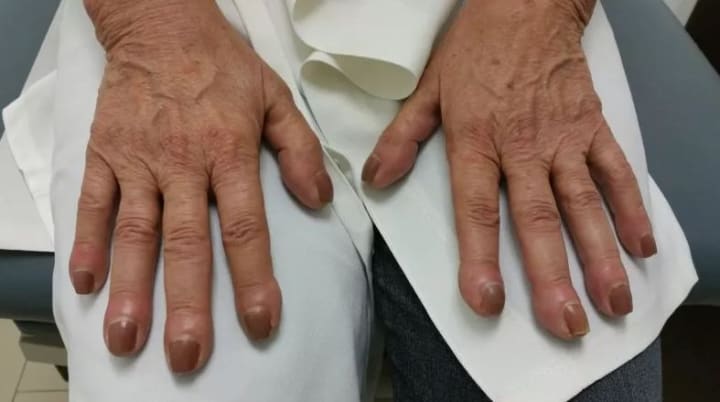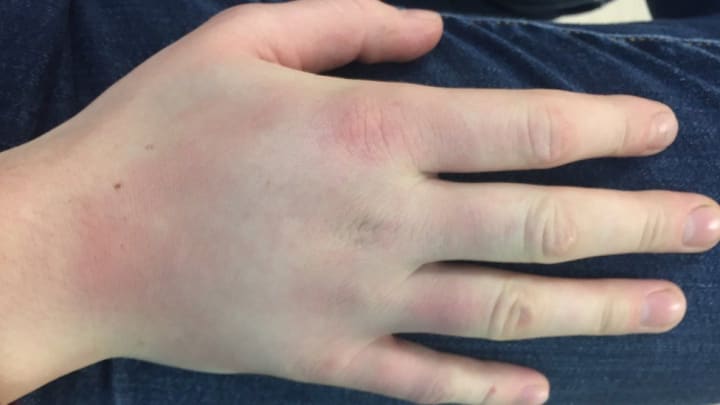Open your hand and see these 3 signs, be careful of cancer and heart disease
Your hands can tell you a lot about your health, including your risk of heart disease or cancer.

Heart disease is the second leading cause of death in the UK, claiming the lives of more than 60,000 people each year. While genetic factors can influence the likelihood of developing heart disease, early detection can lead to interventions such as dietary changes or medication.
Lung cancer, the fifth leading cause of death in the UK, claims the lives of 95 people every day in this country. Besides adopting healthier habits like quitting smoking to reduce your risk of developing lung cancer, detecting symptoms early can increase survival rates by up to 20 times.
Even though your hands are located far from your heart and lungs, they can exhibit many different symptoms that indicate something is wrong in the body. Although most of these signs are likely harmless, some may indicate it's time to see a health care professional.
Below are 3 signs on the hands that can warn of heart disease or cancer.
1. Finger clubbing

When your finger or toe begins to swell at the tip and the skin around the nail becomes shiny, this is called clubbing. This condition often results in a change in the shape of the nail as the tip swells, often becoming hot and red.
Clubbing usually develops gradually over years but can occur suddenly if there is a lung abscess. Mount Sinai Hospital says lung cancer is the most common cause of finger clubbing. However, this sign can signal other health problems and not everyone with lung cancer will have finger clubbing.
To know if you have clubbed fingers or not, you can check yourself at home with a very simple test.
2. Joint swelling

Typically, high cholesterol levels (one of the risk factors for cardiovascular disease) can only be determined through a blood test. However, for people with familial hypercholesterolemia, eating too much fast food and not taking care of themselves can lead to swollen finger joints. This is caused by a buildup of cholesterol around the tendons, which can impact the knuckles on the hands, knees, and Achilles tendons.
Although high cholesterol levels and heart disease are more common in older people, if you have familial hypercholesterolemia, joint swelling may begin in adolescence.
Only 8% of people with this genetic disease are confirmed by medical authorities, so if you observe swelling in your knuckles and other yellow bumps on your hands or around your eyes, you should go see a doctor.
Additionally, swelling in the legs and feet can be a sign of heart disease, according to the American Academy of Dermatology. "Many heart conditions cause fluid to build up in the feet and lower legs. As fluid builds up, you may notice swelling that can extend into the calves and groin," the American Academy of Dermatology notes.
3. Unusually bruised fingers

Another warning sign is the sudden appearance of bruises on the fingers. This is quite unusual and could indicate a blood-related problem.
Unless you've been hit or seriously injured, it's rare to have unexplained bruises on your fingers. This is often a signal for doctors to test for forms of cancer.
Leukemia UK's research director, Simon Ridley, told Express: "One of the common warning signs and symptoms of leukemia is bruising. These bruising are different with the bruises we occasionally experience because they can appear in unusual or unexpected locations, such as on the hands."
Leukemia, also known as leukemia, is a cancer of the body's blood-forming tissues, including the bone marrow and lymphatic system.
Leukemia claims the lives of nearly 5,000 Britons every year. Despite significant advances in treatment, it still has a 40% mortality rate. Detecting signs early and reporting them to your doctor is the best way to increase your chances of survival.
If your fingers change color without bruising, this could also be a sign of Raynaud's phenomenon, where blood flow to your fingers and toes stops, causing discoloration. This is often triggered by stress but is usually harmless. If your hands are painful or associated with other conditions, it could be a sign of lupus or Crohn's disease.
About the Creator
Ken aquariums
Telling stories my heart needs to tell <3 life is a journey, not a competition
If you like what you read, feel free to leave a tip,I would love some feedback
https://sites.google.com/view/hk-decor/trang-ch%E1%BB%A7
Enjoyed the story? Support the Creator.
Subscribe for free to receive all their stories in your feed. You could also pledge your support or give them a one-off tip, letting them know you appreciate their work.






Comments
There are no comments for this story
Be the first to respond and start the conversation.